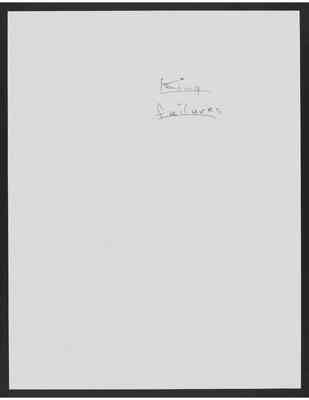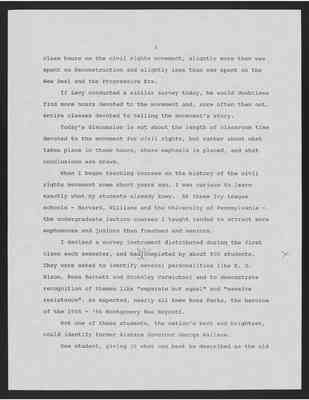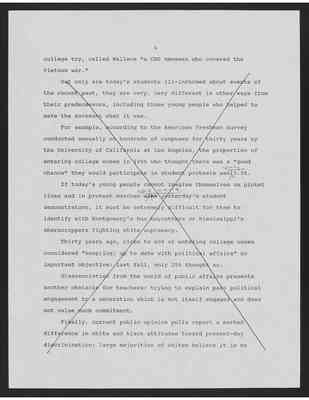Pages
1
1 UVA/June 28, 1997/histeach copyright 1997 by Julian Bond
The challenge for teachers and scholars of the 20th century struggle for civil rights is to make their students' understanding of the movement both broader and deeper, and available to their lives today.
Deeper, because it is now clear that the movement's list of participants and its sites of engagement are far more numerous than was previously acknowledged.
Broader, because the previous decade-long chronological constraint, from Brown in 1954 and Montgomery in 1955 to the triumph of the Civil Rights Act in 1964 and the Voting Rights Act of 1965 has served to limit understanding of who made the movement, of what its origins were, and when or if it may rightly be said to have begun and ended.
Available, because this history is played out daily in their lives
This challenge has already begun to be met; within the last several years, new monographs with new interpretations have appeared, introducing historians and teachers to a less limited and more complex understanding.
Additionally, many of the movement's actors are now speaking for themselves. Among them are women, white and black, who resent the way standard histories have ignored or marginalized them, making them helpless victims of male chauvinism in a social
3
2
movement which in fact, came closer to the ideal of sexual egalitarianism than any other, before or since. They are determined that their stories will be told.
In my few minutes, I want to discuss how this history is changing, how it was taught and how it might be taught in the future, influenced by a rich collection of new histories, biographies and autobiographies, and documentaries, most offering a look at history from the bottom up, most offering stark contrast to the standard top-down history that characterized movement history in the recent past.
And I want to close with an example of a famous movement moment, discussing how it might be approached today.
A decade ago, historian Peter Levy surveyed 150 college and university history departments, inquiring whether they taught courses in civil rights history at all.1
Approximately one-third of his survey sample responded affirmatively, and the number would surely be greater today.
On average, Levy's survey found teachers of one-semester courses on modern American history spent 3.7 class hours on the civil rights movement, about the same time spent on the Vietnam War.
In two-semester courses on Afro-American history, teachers spent 6.5 class hours on the civil rights movement, three times as much as on the Harlem Renaissance and 50% more than on Reconstruction.
In two-semester U. S. history courses, teachers spent 2.4
4
3
class hours on the civil rights movement, slightly more than was spent on Reconstruction and slightly less than was spent on the New Deal and the Progressive Era.
If Levy conducted a similar survey today, he would doubtless find more hours devoted to the movement and, more often than not, entire classes devoted to telling the movement's story.
Today's discussion is not about the length of classroom time devoted to the movement for civil rights, but rather about what takes place in those hours, where emphasis is placed, and what conclusions are drawn.
When I began teaching courses on the history of the civil rights movement some short years ago, I was curious to learn exactly what my students already knew. At three Ivy League schools – Harvard, Williams and the University of Pennsylvania – the undergraduate lecture courses I taught tended to attract more sophomores and juniors than freshmen and seniors.
I devised a survey instruction distributed during the first class each semester, and had it completed by about 800 students. They were asked to identify several personalities like E. D. Nixon, Ross Barnett and Stokeley Carmichael and to demonstrate recognition of themes like "separate but equal" and "massive resistance". As expected, nearly all knew Rosa Parks, the heroine of the 1955 - '56 Montgomery Bus Boycott.
Not one of these students, the nation's best and brightest, could identify former Alabama Governor George Wallace.
One student, giving it what can best be described as the old
5
4 college try, called Wallace "a CBS newsman who covered the Vietnam war."
[The remainder of this page is crossed out.]
Not only are today's students ill-informed about events of the recent past, they are very, very different in other ways from their predecessors, including those young people who helped to make the movement what it was.
For example, according to the American Freshman Survey conducted annually on hundreds of campuses for thirty years by the University of California at Los Angeles, the proportion of entering college women in 1996 who thought there was a "good chance" they would participate in student protest was only 5.5%.
If today's young people cannot imagine themselves on picket lines and in protest marches with as were yesterday's student demonstrators, it must be extremely difficult for them to identify with Mongomery's bus boycotters or Mississippi's sharecroppers fighting white supremacy.
Thirty years ago, close to 60% of entering college women considered "Keep{ing] up to date with political affairs" an important objective; last fall, only 25% thought so .
Disassociation from the world of public affairs presents another obstacle for teachers; trying to explain past political engagement to a generation which is not itself engaged and does not value such commitment.
Finally, current public opinion polls reprt a marked difference in white and black attitudes toward present-day discrimination; large majorities of whites believe it is no




